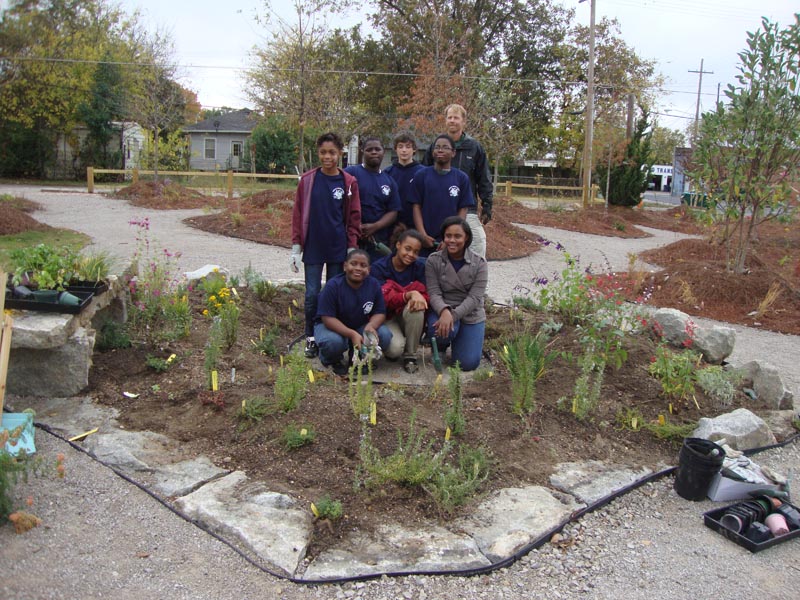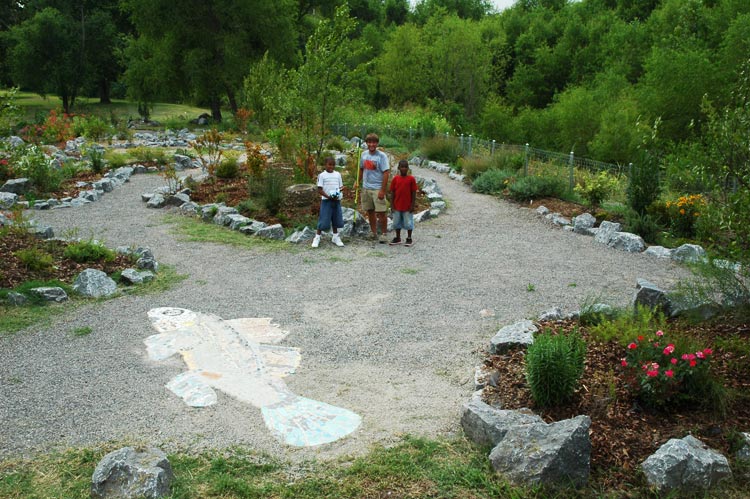The EcoScape Program
The EcoScape Program
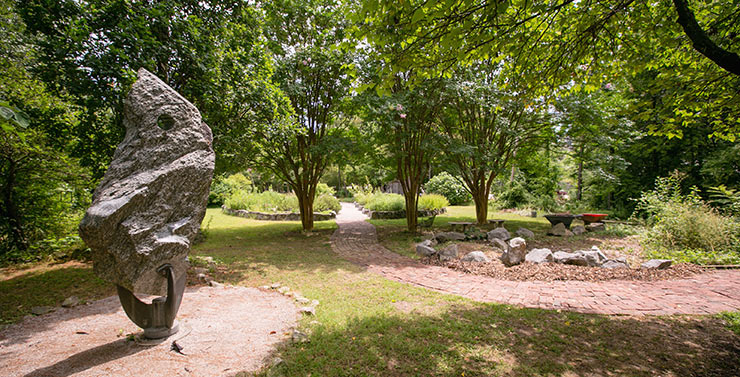
Established in 1996 on the campus of Birmingham-Southern College, this program has expanded to the surrounding communities and utilizes local art work to illustrate organic gardening practices, offer outdoor classrooms, and offer urban neighborhoods a pocket of green space for rest and recreation. These oases vary according to community needs and demonstrate how vacant properties can be transformed into anchors for revitalization.
The program has been recognized nationally: the Woodlawn EcoScape received the 2004 Urban Garden Award from Keep Birmingham Beautiful and the Arlington-West End EcoScape was voted one of the best small-scale community revitalization projects of 2005 by the national nonprofit group Neighborhoods USA.
All EcoScapes are open to the public, although some have limited hours. Hugh Kaul EcoScape, North Birmingham EcoScape, and Sims EcoScape are open daily during daylight hours. For Turkey Creek Nature Preserve hours, please click here. For more information or to plan a visit, click on one of the tabs below.
-
Arlington-West End EcoScape
Cotton Avenue and 9th Street SW
The Arlington-West End EcoScape is located on the corner of Cotton Avenue and 9th Street SW and is modeled after the Woodlawn EcoScape. The EcoScape is designed for use as a passive recreational facility. The objective is to create a botanical setting complete with flowerbeds, seating areas, and panoramic vistas. Mosaic stepping stones and park benches were designed by students from local schools. Chris Fennell's massive flower sculpture, made from recycled roofing material, draws the attention of traffic along Cotton Avenue to this wonderful neighborhood green space. The Arlington-West End EcoScape makes extensive use of recycled pavers, woodchips, and soil amendments, adding to its value as an outdoor classroom.
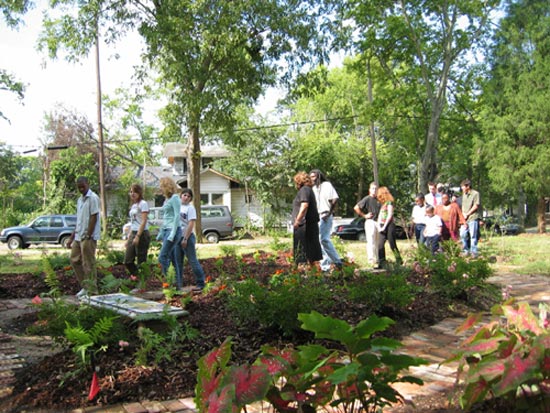
Students, residents, and officials joined us for the dedication. -
Brown Springs
73rd Street and Oporto Avenue
Located at 73rd Street and Oporto Avenue, the Brown Springs EcoScape is constructed on a vacant lot owned by the City of Birmingham. The garden is designed for use as a passive recreational facility complete with flower beds, seating areas, and panoramic vistas. An effort has been made to restore the natural spring, which historically served this community. Future plans also call for the replanting of a small orchard on an adjacent lot for use by the community.
The location of this EcoScape directly complements the objectives outlined in Ruffner Mountain's master plan. 73rd Street provides historical access to the nature center, and the garden will serve as a local landmark for users of the trail system.
Phase One project sponsors include Brown Springs Neighborhood Assoc., Councillor Valerie Abbott, Wachovia Foundation, Tractor & Equipment Company, Wade Sand and Gravel, and Commissioner Shelia Smoot.

-
The College Hills Ecoscape
Located within walking distance of Birmingham-Southern College (BSC), the College Hills EcoScape was dedicated on June 9, 2007. The ornamental entrance to this 10,000 square foot outdoor classroom and community park incorporates one of the original gateways to BSC. Raised vegetable and herb gardens are utilized by Camp NorthStar's Youth Ministries, and a hand painted park bench is just one of several local art works that grace this charming pocket park. Project sponsors include the College Hills Neighborhood Association, the Associated Colleges of the South, and Wade Sand & Gravel.
In 2012, Southern Environmental Center expanded its partnership with College Hills by planting over 50 street trees along 9th Avenue. A native plant bed now provides year round color at the entrance to College Hills, and a stone bench was installed at the 9th Avenue bus stop. Funding support was provided by the City of Birmingham.
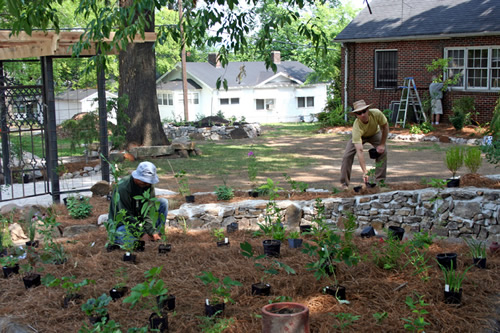
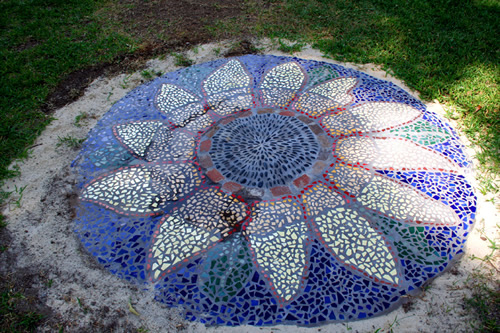
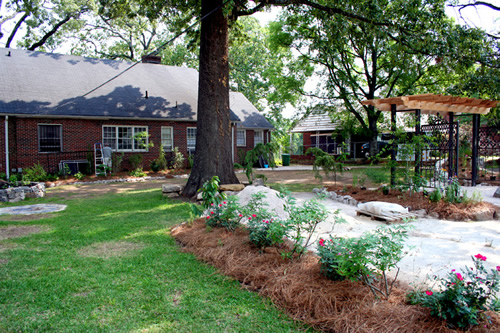
-
The Hugh Kaul EcoScape
Photos of the EcoScape
Plants of the Alabama MeadowEstablished in 1996 on BSC's campus, this wonderful outdoor classroom utilizes local
art work to illustrate organic gardeningpractices, and provides a nuts and bolts overview for schools and communities interested in creatinglow cost nature centers or outdoor learning sites.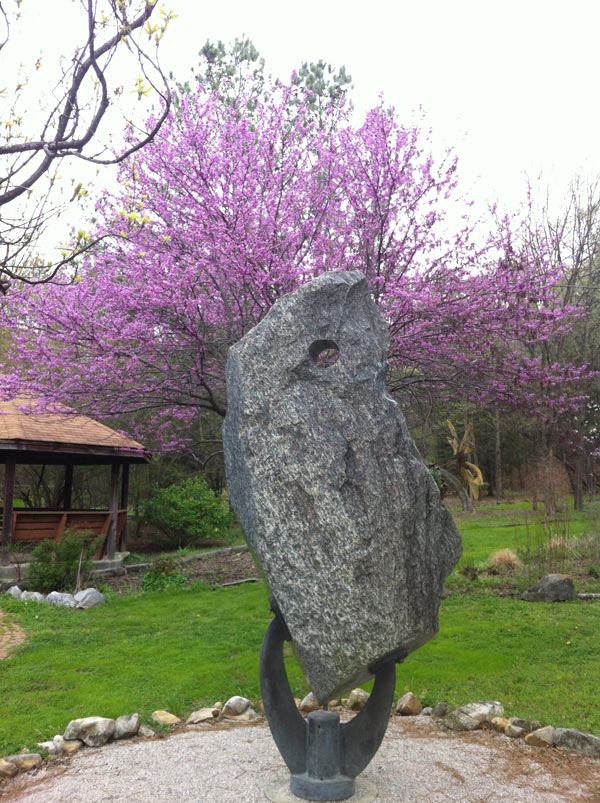
Visitors can stroll through a Northern Wildflower Garden, touch and sample edible plants and flowers, and pass by huge Praying Mantis and Whooping Crane sculptures on the way to the EcoScape's Wetland and Tree Trails.
The EcoScape also provides a unique focus on water issues, ranging from Xeriscaping to Nonpoint Source
pollution . Technically complex issues are presented in layman terms, and in a way that challenges visitors to contribute to change at the workplace or at home.Ecoscape Map
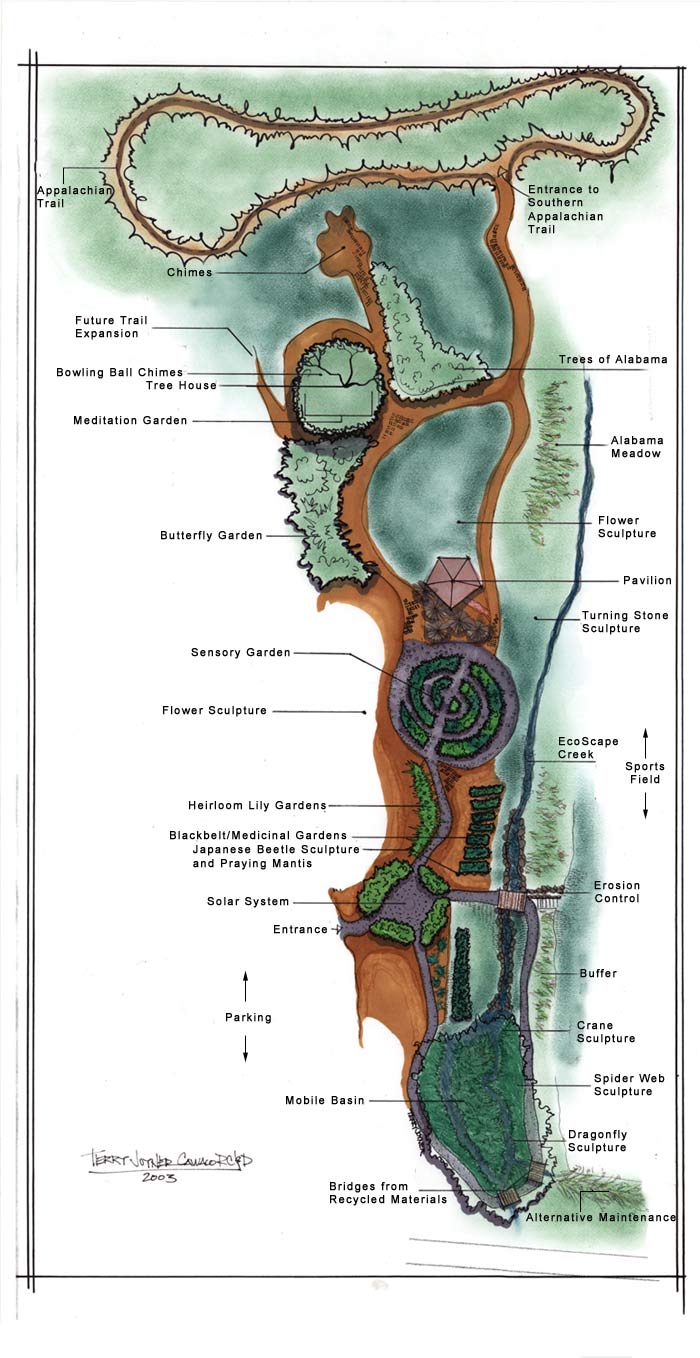
-
North Birmingham
2619 30th Avenue North
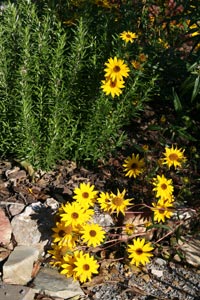 North Birmingham EcoScape is located next to a Wells Fargo Bank branch on 2619 30th Avenue North and was officially dedicated on October 14, 2010. Similar in design to the Healing Garden at Princeton BMC, the North Birmingham EcoScape features drought resistant native wildflowers, raised herb beds, fruit trees, and shrubs. A winding gravel pathway leads visitors past azalea alcoves, centered by hand painted park benches. An open lawn area at the center of the garden serves as both a play & picnic area. North Birmingham EcoScape is within walking distance of a senior living facility and a public library, and serves as an aesthetically pleasing gateway to the North Birmingham business district.
North Birmingham EcoScape is located next to a Wells Fargo Bank branch on 2619 30th Avenue North and was officially dedicated on October 14, 2010. Similar in design to the Healing Garden at Princeton BMC, the North Birmingham EcoScape features drought resistant native wildflowers, raised herb beds, fruit trees, and shrubs. A winding gravel pathway leads visitors past azalea alcoves, centered by hand painted park benches. An open lawn area at the center of the garden serves as both a play & picnic area. North Birmingham EcoScape is within walking distance of a senior living facility and a public library, and serves as an aesthetically pleasing gateway to the North Birmingham business district.View a slideshow of photographs of the North Birmingham Ecoscape.

-
Princeton Baptist Medical Center EcoScape: The Healing Garden
10th Street SW and Tuscaloosa Avenue
(across the street from Princeton Towers)The Healing Garden, located on the Princeton Baptist Medical Center campus, combines specially designed visual arts exhibits with fragrance and wildflower gardens to serve as a therapeutic tool for hospital staff, residents of Princeton Towers, and their families, as well function as a community park. It serves as an outdoor classroom for local high schools and colleges.
The garden is the first of its kind in Alabama and features herbs, fruit trees, and flowers traditionally grown in the 1940s and 1950s. The front fence was made by local artist Heather Spencer and is designed to resemble the famous Gee's Bend quilt patterns. The center of the garden features a water sculpture created by BSC Art Professor Jim Neel.
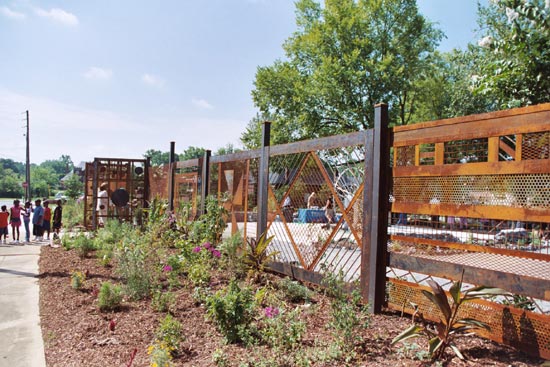
The recycled wrought iron fence was designed to resemble the famous
Gee's Bend quilt patterns. Design and installation by Arnie Rutkis. (stoneshovel.com) -
Princeton Baptist Medical Center Ecoscape: The Sound Garden
Princeton BMC's Professional Building
Princeton's Sound Garden provides hospital staff and visitors alike with a place to recharge. Its fountain, wind chime sculpture, and multi-colored Bottlehead sculpture surround umbrella covered tables. A Wellness Walk lined with colorful sunflower banners leads to the nearby Healing Garden at Princeton Towers. Designed by Altamont School art students, the banners depict stages of the sunflower's life cycle. Funding support from this project came from Princeton Baptist Medical Center and the Cultural Alliance of Greater Birmingham.
Also tour the Princeton Baptist Medical Center EcoScape Healing Garden by clicking on the tab above this one.
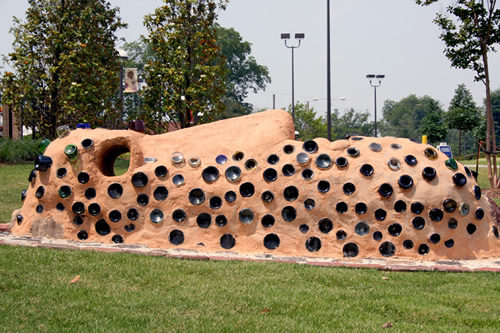
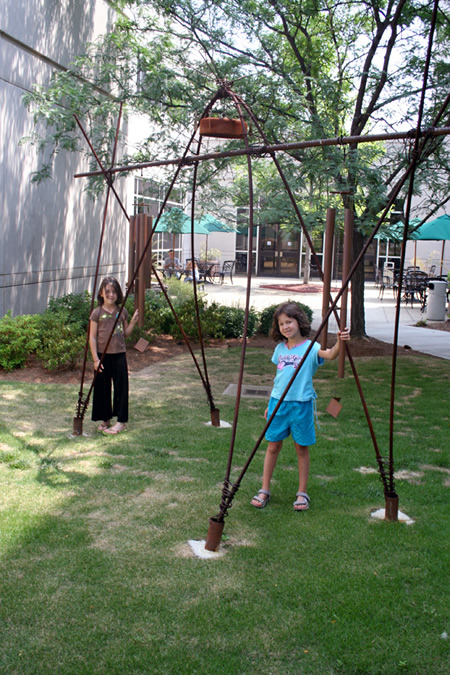
-
Riley-Travellick EcoScape

Located in southwest Birmingham and bordering Midfield, the Riley-Travellick neighborhood was developed in 1888 as a planned community for low income workers by the Beneficial Land and Improvement Company. The neighborhood has suffered from population decline over the years, and during the 1990s, the Riley area became a center for illegal drug distribution under the Insane Gangster Disciples.
Southern Environmental Center's newest EcoScape was completed on September 17, 2012 and now serves as an anchor for community revitalization. We recently added a pavilion that will be used for community festivals.
Riley-Travellick EcoScape is in close proximity to Red Mountain Park, as well as the proposed Valley Creek Greenway.
 This is the site before construction began.
This is the site before construction began.
Riley-Travellick EcoScape -
Samuelson EcoScape
Eastern Health Center
The Eastern Health Center garden is the 10th Community EcoScape designed by the Southern Environmental Center (SEC) since 1996. It consists of a series of interconnected gardens filled with native wildflowers, edible plants, and herbs. Designed for year-round color and fragrance, its paths connect a meadow garden and Southern woodland garden.
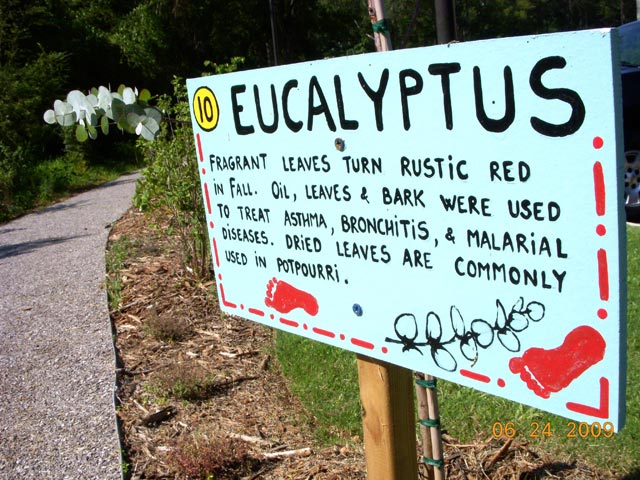
Signage at the Paul Samuelson EcoScape highlights medicinal plants and folklore. In addition, a trail system will eventually provide an access point to a proposed greenway linking the health center by way of Hawkins Park to East Lake Park.
As part of its partnership with the Jefferson County Department of Health (JCDH), SEC will develop a community usage program for the area. Potential projects include a Saturday farmer's market managed by East Lake United Methodist Church, and a garden training program for women residing at the Lovelady Center. In addition to its drug treatment programs, the Lovelady Center houses a work-release program for Tutwiler prison, and assists DHR child custody cases. SEC will also help JCDH develop potential community wellness programs like yoga in the gardens and nature education programs for area youth.
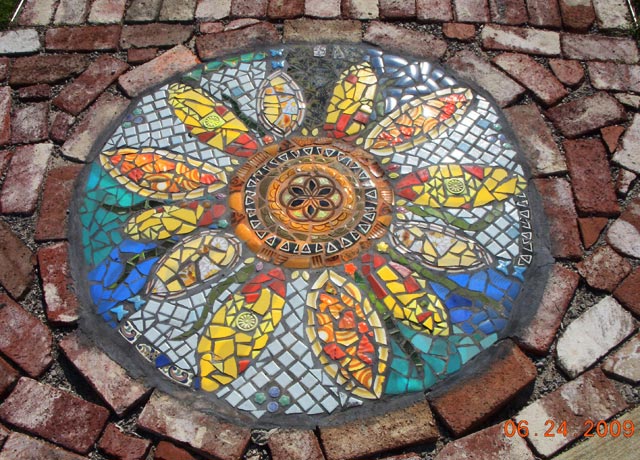
Funding support for this project came from the Jefferson County Public Health Fund and also the Samuelson Fund for Public Health.
-
Seven Springs, Powderly. AL
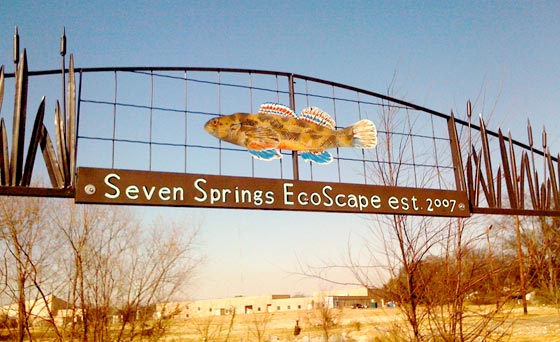
In April 2008, the Southern Environmental Center dedicated the Seven Springs EcoScape on the grounds of Faith Apostolic Church in southwest Birmingham. The EcoScape is designed to protect a spring-fed tributary of Valley Creek. It is home to a tiny Endangered fish, the two-inch-long, red-and blue-finned Watercress Darter. The fish is known to exist only in Roebuck Springs, Pinson, Bessemer, and Seven Springs in the Powderly community. The spring's population of watercress darters was discovered by Samford University biologists Mike Howell and Larry Davenport and led to an agreement in 2005 between the church and the Freshwater Land Trust to ensure the permanent protection of the watercress darter and its habitat. The following year, U.S. fish and Wildlife Service, Samford University's biology department, and the Southern
Environmental Center joined the partnership. The EcoScape was completed with the help of a Five Star Restoration Challenge Grant.
SEC Director, Roald Hazelhoff, is currently developing an environmental education program for community residents that highlights the rare fish and its significance in the local ecosystem. The EcoScape will also serve as an outdoor classroom and meditation site. The garden's winding pathways, bounded by limestone boulders, wind through beds planted with native plants and flowers. Faith Apostolic Church hopes to eventually extend the EcoScape along the spring out to 24th Street Southwest. That street extends to the borders of Red Mountain Park.
-
Sims EcoScape
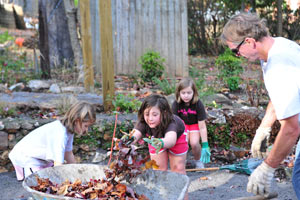 This EcoScape is spread across 5 adjacent lots in Homewood, and is named in honor of Catherine Sims. Affectionately known as the Plant Lady of Edgewood, Catherine was passionate about gardening, and appreciated even the smallest detail of each flower. In her will, she deeded her property to the City of Homewood, with the stipulation that it be maintained as a community park and outdoor classroom. After an initial lag period during which the site became overgrown with weeds, the Southern Environmental Center at Birmingham-Southern College was brought in to do a total makeover.
This EcoScape is spread across 5 adjacent lots in Homewood, and is named in honor of Catherine Sims. Affectionately known as the Plant Lady of Edgewood, Catherine was passionate about gardening, and appreciated even the smallest detail of each flower. In her will, she deeded her property to the City of Homewood, with the stipulation that it be maintained as a community park and outdoor classroom. After an initial lag period during which the site became overgrown with weeds, the Southern Environmental Center at Birmingham-Southern College was brought in to do a total makeover.Today, the 3 lower lots are covered with native grasses, plants, and heirloom roses. The upper garden includes a brick patio, moss rock seating wall, bamboo fence, and a tool shed which showcases a green roof & rainwater collection system. Catherine's former greenhouse has
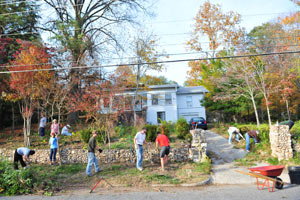 been restored, and is surrounded by compost demonstration lots. A bio-swale adjacent to the new parking area captures and slows storm water runoff, while passively watering plants. A massive Sycamore tree propagated by Catherine stands guard over the entire property and provides song birds a perching place.
been restored, and is surrounded by compost demonstration lots. A bio-swale adjacent to the new parking area captures and slows storm water runoff, while passively watering plants. A massive Sycamore tree propagated by Catherine stands guard over the entire property and provides song birds a perching place.Behind Ms. Sims former home, a quiet courtyard space provides a perfect setting for receptions or lectures. No EcoScape would be complete without an edible landscape, and you'll find plenty of blueberries, figs, muscadines, peaches, mayhaw, rosemary, thyme and oregano. Catherine would have wanted it that way.
View a map of the Sims EcoScape.
Follow Sims EcoScape events here.
-
Tarrant EcoScape
Located at 1113 Ford Avenue in downtown Tarrant, this novel project provides natural restoration to a vacant lot that at one time housed a dry cleaning business. Designed for passive recreation and use as an outdoor classroom, Tarrant EcoScape's bioswales mitigate stormwater runoff from adjacent parking lots. Fonde Taylor's ornamental fence gives a second life to metal waste and serves as a frame for climbing roses. The park features a mosaic fountain, benches made from reclaimed granite street curbs, and herb garden planted by Tarrant Middle School students.
Phase II plans call for a culinary arts cafe to open across the street from Tarrant EcoScape, and for locally designed street banners along Ford Avenue to draw in traffic from nearby Hwy 79.
